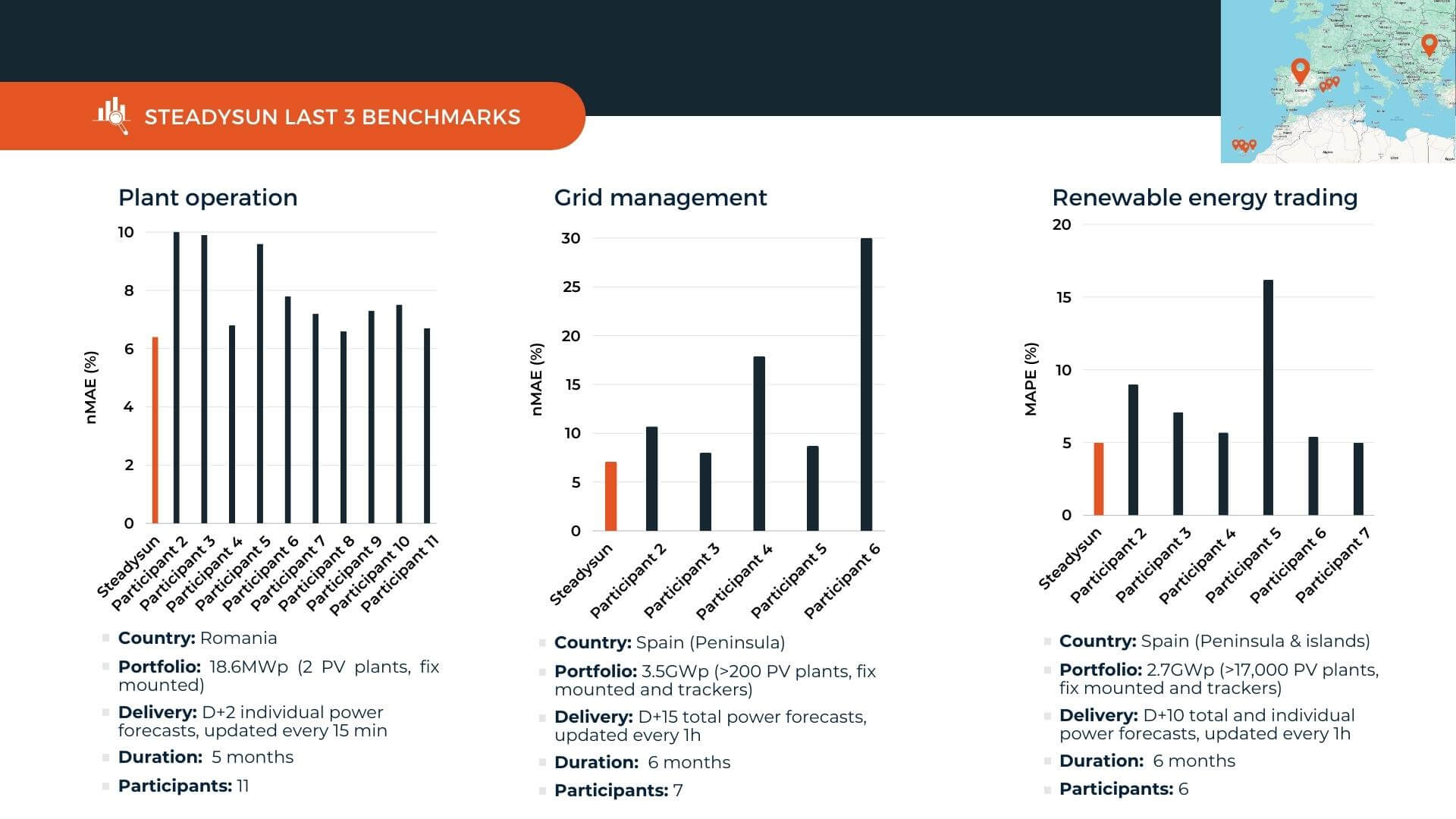Steadysun tops the last three benchmarks we took part
null
Company news
30/11/2023
by
Nathalie Desbrosses
10 min
null
null
We are pleased to announce that we have ranked at the forefront in the last three solar energy forecasting benchmarks in which we participated. These rigorous comparison exercises, spanning 5 to 6 months, engaged 6 to 11 participants and included power plants in both Spain and Romania. These forecasts were updated at intervals as short as 15 minutes, covering time horizons from a few hours up to 15 days ahead. Our success across diverse portfolios and technologies emphasizes our expertise in providing highly accurate forecasts.
This benchmarking approach stands as a common industry practice employed by companies to evaluate the quality of various renewable energy forecasting services. Typically engaging about 10 suppliers, these analyses concentrate on identical power plants over concurrent timeframes, utilizing shared data among all participants. The accuracy of forecasts plays a crucial role for operators in determining the most suitable forecasting service for subscription. The organization of such a benchmarking is important for our customers, but very time-consuming. At the end of this article you will find some recommendations that will help you to save time if you want to organize a benchmarking in the near future.
null
null
null

null
null
null
We were able to achieve this results primarily thanks to the real-time monitoring of forecasts and the introduction of our new forecasting system, at the beginning of 2023, which integrates significant improvements throughout the forecasting chain:
➡️ It combines a growing amount of various heterogeneous data sources from Numerical Weather Prediction (NWP) models, satellite imagery and in-situ observations.
➡️ It integrates four additional ensemble/deterministic NWP models into our existing pool of >10 global and regional models, to mitigate the occurrence of extreme errors and improve the overall accuracy of our forecasts.
➡️ Its cutting-edge approach considers the performance levels of each model, regional dependencies, and temporal patterns to generate more robust forecasts that account for varying meteorological conditions across different regions and timeframes.
➡️ It relies on an upgraded satellite-based solar irradiance nowcasting model (night time cloud detection, advanced optical flow and atmospheric radiative transfer).
➡️ It uses more efficient techniques, like improved topographical and aerosol modeling. Additionally, it runs with enhanced statistical corrections, including analog-based approaches, to ensure the highest level of forecast accuracy.
Among others, those improvements have increased accuracy ━ we have estimated an overall +5-10% gain in annual normalized Mean Absolute Error ━ empowering our clients to make informed decisions.
These positive results reinforce Steadysun's position as a leader in the renewable energy forecasting industry.
null
null
null
Steadysun tops the last three benchmarks we took part
null
null
Want to try our forecasting solutions too?
null
Are you involved in developing PV or wind farms, operating power plants, managing power systems or portfolios of solar/wind assets?
Contact-us for information about our services or test our forecasts free of charge for 30 days.
For faster assessments over a longer period, we also offer hindcast data on demand. Choose the trial, benchmark, or hindcasts that suit your needs, and experience top-quality data and services from Steadysun!
null
null
.jpg)
null
null
null
null
null
null
null
null
null
null
null
null
null
null
null
null
null
null
null
null
null
null
null
null
null
null
null
null
null
null
null
null
null
null
null
null
null
null
null
null
null
null
null
null
null
null
null
null
null
Recommended practices on renewable energy forecast solution selection
Here is a list of best practices to help you organize benchmarks in the best conditions provided by the International Energy Agency:
- Establish a clear objective: Clearly define the purpose of the benchmark exercise.
- Define explicit metrics and criteria: Pre-determine accurate metrics and criteria for assessment, providing a transparent basis for solution selection.
- Create a well-defined timeline: Develop a comprehensive timeline, specifying start/end dates, selection announcements, and contract award dates to maintain clarity and efficiency.
- Ensure anonymity in results sharing: Seek approval from forecast service providers to share anonymized forecast results, fostering an environment for improvement and self-awareness regarding forecast accuracy.
- Facilitate Q&A period before commencement: Allocate 1–2 weeks for a question-and-answer period before the benchmarking period begins, ensuring participants are well-informed and prepared.
- Allocate adequate time for data transfer testing: Dedicate sufficient time to test the transfer of data between participants and operators, allowing for a seamless and effective collaboration.
- Maintain prompt communication: Ensure timely communication with all participants regarding any changes in benchmark design or protocols, addressing questions from participants promptly.
- Consistent forecast file format: Request a consistent forecast file format from all participants and provide an example file, promoting uniformity in data submission.
- Uniform data formats: Strive for consistency in data formats (both observations and forecast files), ideally aligning with the needs of the benchmark operator upon contract execution.
- Provide identical historical and project metadata: Furnish the same historical and project metadata to all participants, creating a level playing field for evaluation.
- Allocate adequate resources for validation: Ensure that the person responsible for the benchmark allocates sufficient resources to provide data and perform validation, enhancing the robustness of the benchmarking process.
[1] IEA Wind Recommended Practice for the Implementation of Renewable Energy Forecasting Solutions. 270 pp. Elsevier Academic Press, November 1, 2022. ISBN: 9780443186813.
null
null
null
null
null
